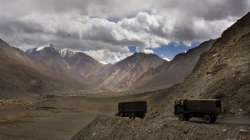India Vs China: Disengagement of troops in 3 phases but India remains watchful
In the first signs of easing tensions along the LAC in eastern Ladakh, China has begun disengaging its troops from flashpoint sites. Armies of India and China will move back in three phases, sources have told India TV.

In the first signs of easing tensions along the LAC in eastern Ladakh, China has begun disengaging its troops from flashpoint sites. Armies of India and China will move back in three phases, sources have told India TV. The entire process would take a period of 30-60 days. Even as both sides agreed to pull back troops in different phases, sources in the Indian Army said it will be watchful and prepare for any Chinese manoeuvres at the border.
This comes after NSA Ajit Doval spoke to Chinese Foreign Minister Wang Yi over phone and agreed on completing the ongoing disengagement process along the LAC expeditiously. Doval and Wang re-affirmed that both sides should "strictly respect" and observe the Line of Actual Control (LAC) and should not take any unilateral action to alter the status quo. The situation in eastern Ladakh deteriorated after around 250 Chinese and Indian soldiers were engaged in a violent face-off on May 5 and 6.
FIRST PHASE
During the first phase, Indian and Chinese troops will move back 2-3 kilometers away. With this, they will also have to take away all their belongings, structures, tents and bunkers. No one, especially the Chinese PLA, should breach the said agreement. If any violation takes place, the process would end there and then. Chinese soldiers was supposed to move 5 kilometers away, however, they are only 2 kilometers away right now. Sources said if China abides by its word, India too will move back from Patrolling Point 14. It is pertinent to mention here that the weather is not conducive at the moment, and the flow of Galwan river is also fast. This is the reason why Chinese PLA is easily moving back. This will be completely monitored for at least two weeks. The Indian Army will keep verifying the status through satellite imagery and UAVs.
SECOND PHASE
At present, about 35,000 soldiers are deployed on the Chinese side of the LAC. According to sources, these PLA soldiers will have to move back all their weaponry as well, especially from the friction points. It was decided in a Corps Commander-level meeting that both the armies will pull back troops and weapons according to the distance agreed. These mainly include infantry combat vehicle, gun tank and other weapons.
THIRD PHASE
If both the phases pass well, then the Indian Army will further work towards April 2020 status quo and avoid differences at patrolling points. It is also learnt that talks on Pangong Tso will happen in the third phase so that both armies move back to the positions as per April 2020 status quo.
WATCH REPORT